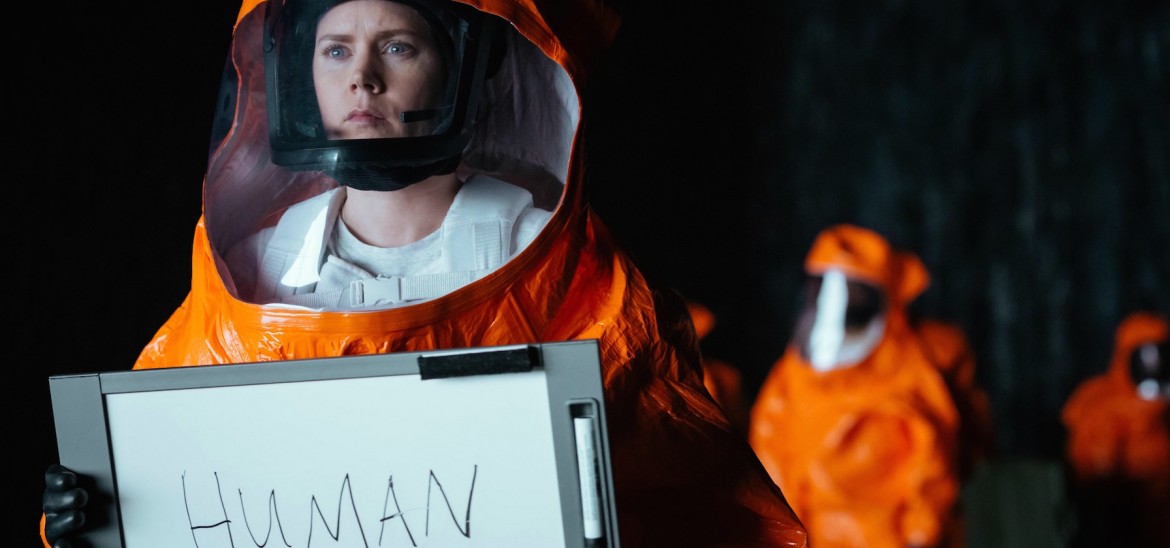Into Film Clubs
Find out everything you need to know about starting an Into Film Club.



Arrival is the latest science fiction film to explore what first contact with alien life might be like. Set in the near future, the film brings this scenario to Earth when an unexplained series of extraterrestrial landings causes nations across the globe to attempt communication with the lifeforms within. Called in to help work out what the purpose of their visit might be, linguistics professor Dr. Louise Banks finds herself teamed up with scientist Ian Donnelly, and although the pair are initially at odds regarding how to make the best of this unprecedented situation, the two eventually come to rely on one another to form their approach.
Preparing for a meeting unlike anything they've ever experienced - the result of which could have consequences for the entire planet - Louise and Ian must rely on their expertise and instincts to negotiate an approach that remains neutral. Alongside their efforts, nations around the world are also brokering their own overtures with the visitors, and the success or failure of any one country's method will affect the outcome for all.
South African film District 9 goes further than depicting just an initial encounter, presenting a vision of what life might be like on Earth if aliens and humans co-existed. In doing this, the film sends a powerful message about to the country's history of apartheid and how people in power treat those that they deem to be different. Other films, such as War of the Worlds, Invasion of the Body Snatchers, and Pacific Rim (along with the more light-hearted Attack the Block and Independence Day), imagine the first alien encounter as a hostile invasion, challenging humanity to find an effective way to repel it.
The science fiction genre allows filmmakers to give vision to concepts that challenge the imagination, and push timely questions to their logical conclusion. Films such as Interstellar contain questions about the future of the planet, and the nature of time - something which also comes to provide an important element in Arrival.
Without communication, it's impossible to tell whether the aliens in Arrival mean good or harm, and during the tense period while this is established, all sorts of conjecture emerges - inevitably fuelled by the global media - which puts additional pressure on the people leading the mission. In Contact - a spiritual predecessor to Arrival - scientist Ellie Arroway's painstaking research is rewarded when she receives noises that she suspects are alien signals. The alien communication is then confirmed by the return of a notorious historical broadcast, which opens up all sorts of political questions. While this stokes fearful hysteria on earth, it's also balanced by a surge of religious fervour, inspired by the possibility of meeting an unearthly being that's potentially divine.
Arrival is also strongly influenced by Close Encounters of the Third Kind, where mysterious UFO sightings lead an otherwise ordinary man to steadily abandon his normal existence as he tries to uncover the meaning behind a repetitive vision that he and the others who claim to have seen the UFOs are experiencing. Both films share the approach of dedicated curiosity towards establishing contact, which involves developing new forms of language that can be understood by earthlings and extraterrestrials alike. The filmmakers of Arrival had to work out both a written and a spoken language for the alien encounter, and the difficulties of interpreting these languages correctly - before other forces influence the situation - is what presents a massive challenge for Louise and her team.
Designing an original vision for what aliens could look and sound like is crucial for filmmakers who want to make their own mark on the science fiction genre. For Arrival, the setting in which communication is made is referred to as the 'shell'. A dramatic and stripped-back reimagining of what a spacecraft could be, the shell is inspired by organic forms and has textures that give the ship the impression of being from a planet - just not ours. The challenge for the sound design is to give the idea of movement - of something otherworldly - without falling back on conventions. This is complicated further by the imposing upright shape of the shell, which also distorts the interior sound where contact takes place. The unnerving sound design is also used to enhance the human aspect of the story. Assaulting the senses, the sound expresses the tension experienced by Louise and Ian, picking up on their feelings of anticipation, pressure, and excitement.
Exploring the possibility of alien encounters allows filmmakers to express wonder in innovative ways, but also to reveal the great fear and doubt that people are susceptible to. In all of these films there is an atmosphere of paranoia, with the protagonists accused of losing touch with reality or heading towards madness because of their experiences. These encounters with the unknown have a disorienting effect, and the characters are shown to struggle with resolving their emotional reactions and their developing theories about why contact has been made.
All of these films consider how space travel - while taking us far beyond the limits of our world - can bring us closer to loved ones we thought we'd lost. Arrival uses the genre to ask questions about what it means to be human, and how we treat the life choices that we make. 'What if?' Is the central idea in most science fiction, and it's the films that take us beyond what we believe to be possible that leave the biggest impression.
In the video below, Amy Adams and Jeremy Renner expand on the film's theme of being accepting of those that are different to us, and reveal whether they would change anything about their lives if they knew how it would all play out.
Explore the themes of Arrival further with our Into Film Recommends podcast below, or log in to SoundCloud to download the podcast and listen on the go.
The Into Film Recommends Podcast Series is also available on iTunes.
Viewing 4 of 4 related items.

Get in touch with your article ideas for the News and Views section.